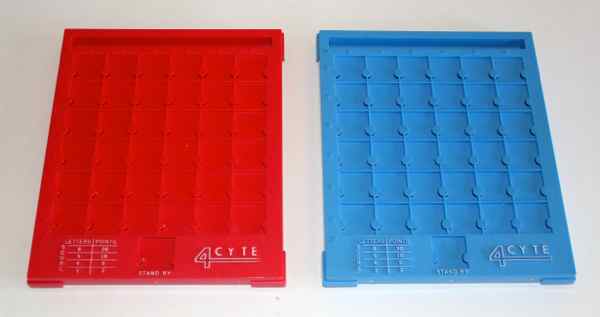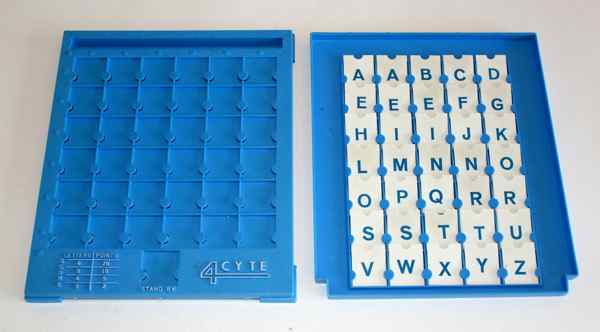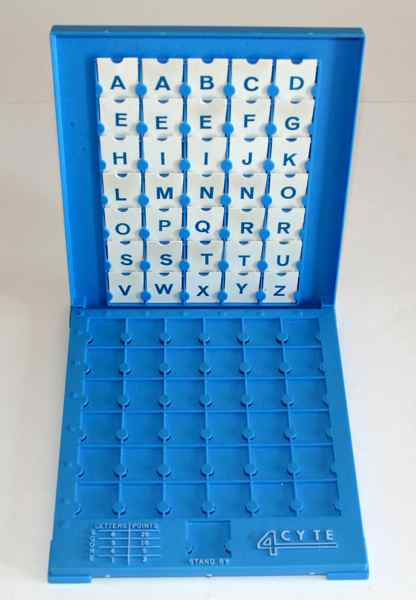4 CYTE Challenges Your Crossword Making Ability
I have enjoyed crossword puzzles and other word games since I was quite young. Some time after 1962, when I was 3 years old, my parents bought the game 4 CYTE for us. It may have been a Christmas or birthday gift – I don’t remember.
That same game has survived to the present day in great condition, except for the outer box. Only three sections of the box have made it down through the years and only because they are the parts containing the rules which were cut apart and placed in another, newer box along with the player boards.
What Are the Player Boards Like?
4 CYTE is a two-player game. You can practice solo, but that’s not really a game. The 1962 version includes a red and a blue board for each player. Each board is identical both in design and in the distribution of letter “tiles” given to the players.

When the boards are closed for storage (as shown above), one of the two sections acts as a cover over the letter holder section. As the only part of setup before a game, each player removes the cover and sets the letter holder into the top slot in the cover (as shown below).
The letter holder, which is now nearly vertical, contains these letters:
A-3, B-1, C-2, D-2, E-5, F-1, G-2, H-2, I-3, J-1, K-1, L-2, M-2, N-3, O-3, P-1, Q-1, R-3, S-3, T-3, U-2, V-1, W-1, X-1, Y-1, Z-1
Each space is designed to easily hold two tiles, which are made of flexible plastic. This explains why you currently see only two letter A’s above, for example.
The lower portion of the board is the playing area. Besides the 36 main empty spaces, there is one space at the lower center which is called “Stand By”. There is also a small grid that reminds you how many points each word will be worth at the end of the game.
How Do You Play 4 CYTE?
Game play itself is so simple that a child of 4 who knows his alphabet could play. But unless he’s very special, he wouldn’t win.
All you do is call out a letter that is still available in the vertical holder and place it anywhere on the lower section in an empty space. The other player must do the same on his board. After letters are placed, the other player does the same.
The trick of course is to use your foresight to anticipate which letters might be called and to place them in your grid in such a way that the maximum number of words of the maximum possible length are spelled out by the end of the game.
Below is a partially completed game.
The red player would have the same letters on his board, but he would likely have placed them in different spaces.
You can form words from left to right, from top to bottom, and along the two longest diagonals from upper left to lower right and from lower left to upper right. You do not have to finish one word before starting another. You cannot move letters from one space to another once you’ve placed them in the 6 x 6 grid.
One exception to that is the Stand By space. The blue player above apparently didn’t know what to do with the letter X when the red player called it, so he temporarily put it in the Stand By space. At any time later in the game, he can pull it out of Stand By and insert it into a regular space in his board. Then a new letter could (again, temporarily) be put into the Stand By slot.
On the board above, the blue player has already completed two words: PHONES and PASTED. It looks like he may be planning on finishing SQUARED across the bottom and maybe something like HALF in the second row. He might consider moving the X from Stand By into the fourth row to spell NEXT. Maybe he’ll also play ROUTED in the last column, if the letters that are called allow it. He should also try to complete his other diagonal that currently starts with S and ends with R. Only 6-letter words count along the two diagonals.
How Do You Win the Game?
After each player has called 18 letters (for a total of 36), both will have their grids filled. (If a letter remains in Stand By, it would have to be placed in the remaining empty grid space.) The game ends and players check to see how many words they were able to form in the rows, columns, and diagonals.
It’s possible to play two 3-letter words in a row or column that do not overlap. If accomplished, both words are counted in the final tally.
Using the scoring table at the bottom of the play section, you add up the value of each word, and the player with the highest total wins. Players may wish to check each other’s boards to verify the words. Players should check their own carefully too, because sometimes you spell a word unexpectedly while working on words in other places or going other directions.
How Much Fun Is 4 CYTE?
We played 4 CYTE a lot (as I recall) when I was young. My parents apparently considered it good enough to buy in the first place and then to keep for decades. The copy pictured here migrated to my house a few years ago. I haven’t played it much since then, but I plan to keep it and teach it to anyone willing to give it a try. Perhaps our grandchildren will appreciate it as well.
If you like crosswords and have a knack with words, I think you’ll enjoy this game too.
Note: A European version called Lettera was also produced.



